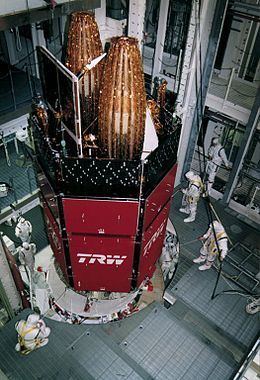Inclination 14.09° Launch mass 3,180 kg COSPAR ID 1995-035B | Launch site Kennedy LC-39B Inclination 14.09° Launch date 13 July 1995 | |
 | ||
Mission duration 10 years (planned)14+ years (achieved) Longitude 150° West (1995-1996); 171° West (1996-2003); 150.5° West (2004—?); 275.9° West Similar TDRS‑6, TDRS‑3, TDRS‑9, TDRS‑10, TDRS‑1 | ||
TDRS-7, known before launch as TDRS-G, is an American communications satellite which is operated by NASA as part of the Tracking and Data Relay Satellite System. It was constructed by TRW as a replacement for TDRS-B, which had been lost in the Challenger accident, and was the last first-generation TDRS satellite to be launched.
Contents
History
TDRS-7 is based on a custom satellite bus which was used for all seven first generation TDRS satellites. Whilst similar to its predecessors, it differed from them slightly in that twelve G/H band (IEEE C band) transponders which had been included on the previous satellites were omitted. It was the last communications satellite, other than amateur radio spacecraft, to be deployed by a Space Shuttle.
Launch
The TDRS-G satellite was deployed from Space Shuttle Discovery during the STS-70 mission in 1995. Discovery was launched from Kennedy Space Center Launch Complex 39B at 13:41:55 GMT on 13 July 1995. TDRS-G was deployed from Discovery around six hours after launch, and was raised to geosynchronous orbit by means of an Inertial Upper Stage.
Deployment
The twin-stage solid-propellent Inertial Upper Stage made two burns. The first stage burn occurred around an hour after deployment from Discovery, and placed the satellite into a geosynchronous transfer orbit. At 02:30 on 14 July it reached apogee, and the second stage fired, placing TDRS-G into geostationary orbit. At this point it received its operational designation, TDRS-7. It was placed at a longitude 150 degrees West of the Greenwich Meridian, where it underwent on-orbit testing.
Semi-retired
In May 1996 it was moved to 171° West where it was stored as an in-orbit spare, and subsequently entered service. In December 2003, it was relocated to 150.5° West. It arrived the next month, and was returned to storage as a reserve satellite.
